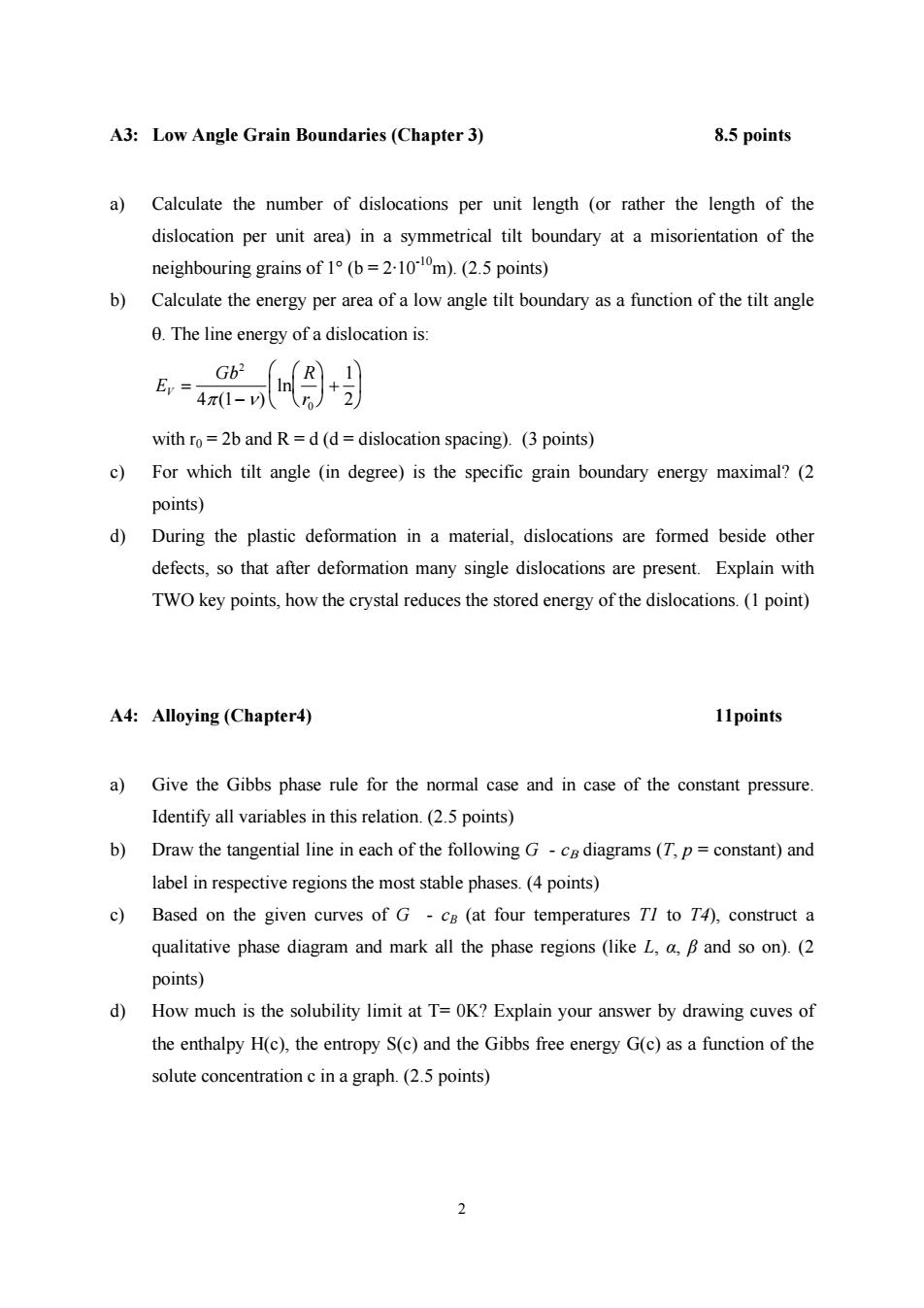正在加载图片...

A3:Low Angle Grain Boundaries(Chapter 3) 8.5 points a)Calculate the number of dislocations per unit length (or rather the length of the dislocation per unit area)in a symmetrical tilt boundary at a misorientation of the neighbouring grains of 1(b=210m).(2.5 points) b)Calculate the energy per area of a low angle tilt boundary as a function of the tilt angle 0.The line energy of a dislocation is: with ro=2b and R=d(d=dislocation spacing).(3 points) c)For which tilt angle (in degree)is the specific grain boundary energy maximal?(2 points) d)During the plastic deformation in a material,dislocations are formed beside other defects,so that after deformation many single dislocations are present.Explain with TWO key points,how the crystal reduces the stored energy of the dislocations.(1 point) A4:Alloying(Chapter4) 11points a)Give the Gibbs phase rule for the normal case and in case of the constant pressure. Identify all variables in this relation.(2.5 points) b)Draw the tangential line in each of the following G-Ce diagrams(T,p=constant)and label in respective regions the most stable phases.(4 points) c)Based on the given curves of G -cs (at four temperatures TI to T4),construct a qualitative phase diagram and mark all the phase regions (like L,a,B and so on).(2 points) d)How much is the solubility limit at T=OK?Explain your answer by drawing cuves of the enthalpy H(c),the entropy S(c)and the Gibbs free energy G(c)as a function of the solute concentration c in a graph.(2.5 points) 22 A3: Low Angle Grain Boundaries (Chapter 3) 8.5 points a) Calculate the number of dislocations per unit length (or rather the length of the dislocation per unit area) in a symmetrical tilt boundary at a misorientation of the neighbouring grains of 1° (b = 2·10-10m). (2.5 points) b) Calculate the energy per area of a low angle tilt boundary as a function of the tilt angle θ. The line energy of a dislocation is: E Gb R r V = − ⎛ ⎝ ⎜ ⎞ ⎠ ⎟ + ⎛ ⎝ ⎜ ⎞ ⎠ ⎟ 2 4 1 0 1 π ν ( ) 2 ln with r0 = 2b and R = d (d = dislocation spacing). (3 points) c) For which tilt angle (in degree) is the specific grain boundary energy maximal? (2 points) d) During the plastic deformation in a material, dislocations are formed beside other defects, so that after deformation many single dislocations are present. Explain with TWO key points, how the crystal reduces the stored energy of the dislocations. (1 point) A4: Alloying (Chapter4) 11points a) Give the Gibbs phase rule for the normal case and in case of the constant pressure. Identify all variables in this relation. (2.5 points) b) Draw the tangential line in each of the following G - cΒ diagrams (T, p = constant) and label in respective regions the most stable phases. (4 points) c) Based on the given curves of G - cB (at four temperatures T1 to T4), construct a qualitative phase diagram and mark all the phase regions (like L, α, β and so on). (2 points) d) How much is the solubility limit at T= 0K? Explain your answer by drawing cuves of the enthalpy H(c), the entropy S(c) and the Gibbs free energy G(c) as a function of the solute concentration c in a graph. (2.5 points)